Llewellyn Publications's Blog, page 40
January 29, 2018
Writing “As If” Can Change Faking Success Into Raking Success
Readers, please enjoy this guest blog post by Bryan E. Robinson, PhD, author of the new Daily Writing Resilience.

“Act as if you’re a writer. Sit down and begin. Act as if you might just create something beautiful, and by beautiful I mean something authentic and universal.” —Dani Shapiro
Raise your hand if you’ve ever been unsure which direction to take with your writing, if self-doubt has nipped at your heels, or if you’ve landed in the clutches of writer’s block or “second book syndrome.”
I thought so.
Most of us who’ve written for any length of time have gotten stuck somewhere along the way. But there’s good news. Twelve Step programs have thrown a phrase around for years called “acting as if.” This principle can help us get through periods of writing paralysis.
What does it mean to act as if? Acting as if is a simple, yet powerful tool that says we can create outer circumstances by acting as if they’re already true. We give ourselves to a certain performance as if it’s how we feel. When we act as if, the mood we pretend becomes a reality.
Suppose we’re angry toward someone who offended us but want to be forgiving. We can start to feel forgiving by acting as if we are forgiving. Perhaps we’re feeling cold and detached but want to be happy for a fellow author’s good news. We can be happy by acting as if we are happy. Maybe we have difficulty getting words on the page, but instead of fighting tooth and nail, we convince ourselves it’s easy, write as if it’s easy, and tackle the difficulty with ease.
Authors of all genres have used this method to jumpstart their writing mojo. The Playwright Tennessee Williams said, “I believe the way to write a good play is to convince yourself it is easy to do then go ahead and do it with ease.” Screenwriter Steven Pressfield also recommends the “as if” approach: “You and I as writers must write as if we were highly paid, even though we may not be. We must write as if we were top-shelf literary professionals, even though we may not (yet) be.”
When I wrote Limestone Gumption: A Brad Pope and Sisterfriends Mystery and em>Daily Writing Resilience: 365 Meditations & Inspirations for Writers, I too, used the “as if” strategy in my fiction and nonfiction work, writing as if my books will be on the shelves beside Stephen King or J. K. Rowling, as if Steven Spielberg will beat down my door to sign me for the screenplay. I’m still waiting for Hollywood to call, but I can testify to the effectiveness of this strategy.
There’s scientific evidence for the old adage when we act as if, the rest of us follows suit. It’s based on the mind-body connection. The cells of our bodies constantly eavesdrop on our thoughts from the wings of our minds. When we’re doubtful or disappointed about our writing, our bodies go with the downturn of our feelings, making us feel worse. Hunching our heads or slumping when we walk makes us come across as insecure.
On the other hand, if we change our body posture, breathing patterns, muscle tension, facial expressions, gestures, movements, words, vocal tonality, it releases a surge of chemicals and changes our internal state. For example, making the facial expression of a smile can make us happy. Or standing tall, shoulders back, not only makes us look confident, but also makes us feel more confident. Training the body to position itself the way we want to think and feel about ourselves adjusts our thoughts and feelings to the way we want them to be. Making body adjustments—pulling our shoulders back, standing or sitting up straight, walking in a more expansive way—can pull us out of self-doubt, disappointment, or any other self-defeating emotion.
When our minds and bodies proceed with the way we want to be (as if), our attitudes navigate us with easy sailing through choppy writing storms. This tool can salvage a bad writing day, repair or prevent a squabble with a fellow author, or kick-start a marathon in front of a blank screen turning dread into enthusiasm.
So let’s convince ourselves that a writing challenge is actually a piece of cake, act as if it’s true, then notice the ease with which an obstacle becomes a cinch to work though. To say we write “as if” is another way of saying that we’re resilient warriors on a literary path, determined to persevere over the long haul.
Our thanks to Bryan for his guest post! For more from Bryan Robinson, read his article “10 Tips for Writing Success.”
January 24, 2018
What’s Old is New
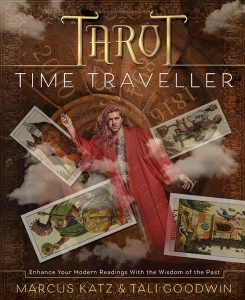
As most tarot readers know, tarot has a long history. Tarot is alive. It changes as we change. Sometimes the old ways are simply no longer relevant and sometimes they just fall out of popular use. In Tarot Time Traveller, Marcus Katz and Tali Goodwin provide not just a fascinating overview of tarot reading throughout the ages but also how to apply these old methods to modern needs.
From Tarot Time Traveller:
You are about to take a journey through time with nothing more than a playing-card deck, a tarot deck and perhaps a Lenormand deck in your hands with the tarot time-traveller to guide you.
On this journey, you will learn how to read the future as you pick up pieces of the puzzle from the greatest tarot teachers throughout history. The tarot time-traveller will escort you in a series of travels to discover many of the eras of tarot and their mysteries.
You will set off to the very beginnings of cartomantic (card-reading) development and learn different ways to read a normal deck of playing cards. You can also time-hop if you wish and choose your own journey of discovery by exploring the time-zones which call to you. You might like to start in the present day and work backwards, for example, or go straight away to the swinging sixties and learn how to read from the rebels of the time or the late Victorian establishment figures who influenced modern tarot.
We hope you will enjoy the experience of learning the whole history of the cards in your hands as much as you learn all the special methods included in this book.
We have used a lot of historical research for this book, along with many unique exercises, so you will also find some fantastic reading lists and decks to explore at the end of each era. You will find each era brought to life with the vignette that opens each chapter and several sections.
And here is a sample of one of the special methods they include in their book. This is, in fact, one I’ve used. It’s very interesting and can, with practice, become quite useful. I’ve included a scan of the original page from Fate Magazine.
A Spread from Fate Magazine (1955)
It is refreshing to go back to the 1930’s-50’s and discover these rare curiosities, although as we have seen, we do have to take early writings with some caution as to their factual basis. In the article, we read about Irys Vorel’s encounter with a Swiss Gypsy, “Boudrie”, who used “colorful Tarots”. The author goes on to talk about “penticles” and the likely origin of Tarot in “the Far East” or “the land of Sumer”, also their popularity during the “Middle Ages”!
Despite these romantic and untrue assertions, the article does contain a couple of gems. It introduces the idea of “assemblation”, a term used to denote how a card is read in conjunction with the card next to it in a reading, and this Yes/No spread, which we reproduce here.
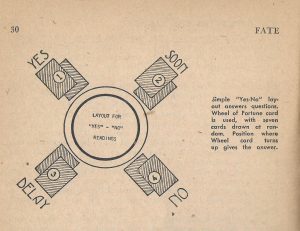
Formulate the question which should have a yes/no answer.
Remove the Wheel of Fortune card and place it face up in front of you.
Shuffle the remaining deck and fan out face-down.
Draw 7 cards at random with your left hand.
Put these 7 cards face-down on top of the Wheel card.
Pick up the 8 cards and turn the Wheel round so it faces as the others.
Shuffle these 8 cards.
Lay out the top four cards as shown in a square face-down, 1-2-3-4
Lay out the next four cards on top, 5th on the 1st, 6th on the 2nd, 7th on the 3rd, and 8th on the 4th.
You now have 2 cards in each corner of the Destiny Wheel.
Locate the Wheel of Fortune in the pairs and the position of that pair gives the answer: Yes, Soon, Delay or No.
Even where there is a “No” answer, the skilled reader can look at the assemblation of the cards to divine what the obstacles and challenges may be to turning this into a positive result.
If you are an absolute beginner, it will give you a complete course in tarot which is rooted in what we might call a true tradition. As an existing expert, you may use it to fill in the gaps of eras which you may not have already explored in depth.
January 23, 2018
The Problem with Personal Gnosis
Readers, please enjoy this guest blog post by Aaron Leitch, author of several books, including Secrets of the Magickal Grimoires, The Angelical Language Volume I and Volume II, and Essential Enochian Grimoire.
It never fails! If you pose a question about a ritual instruction to a group of occultists—hoping academia has discovered the likely origin and/or intent of such an instruction—you’re always going to get multiple responses of, “Why don’t you just conjure the spirits and ask them?” Let me give you a brief example: just go into any occult group and ask them what “butterfly blood ink” is supposed to be. This ink is called for in the Sixth and Seventh Books of Moses where it is required to inscribe the Seals of the spirits. Many people will tell you it is likely ink made of saffron, but no one will know why “butterfly blood” would be saffron, or even if that was the intent of the original author of the grimoire. Then, without missing a beat, it will come: “Why don’t you just ask the spirits?”
Ah, personal gnosis…the practice of learning things directly from spiritual beings. What a touchy subject! On one hand, you have guys like me who insist you should learn your magick directly from your spirits. The spells you find in books can be useful, but they are not spells tailored by your own familiar spirits or Patrons to your specific needs. The book spells can fail, but the spells revealed by your spirits will never, ever, fail when done right.
Yet… I don’t want all of that to give you the impression that books should be avoided! I’ve heard from a disturbing number of individuals who insist all books are worthless, or that no “real” mage would resort to them. Sadly, when you meet this type, they are all over the place, lacking any kind of foundation, and certainly have no knowledge of the basics of how to work with spirits in the first place. If they are in contact with anything at all (besides their own egos), the spirits are doing little more than leading them on a merry chase. Most often I suspect they are just making things up as they go along, and resorting to “personal gnosis” because no one can contradict it.
For certain, there is a time and a place for personal gnosis. When students begin asking me if I think their spirits will like this, or be offended by that, I tell them to ask their spirits. If someone was inspired to write a ritual, and they want me to critique it, I tell them to let their own spirits critique it. Where it comes to how you interact with your spirits, it’s entirely between them and you. My opinion means very little in that regard.
But there is a problem with personal gnosis when it comes into conflict with academic research. There is, in fact, a good reason why we need the books after all. The problem with asking the spirits directly is that YOU may lack the necessary knowledge they would need to convey the ideas to you. Spirits don’t communicate by using vocal cords to vibrate air that bounces off your eardrums. They use what we today would call “telepathy:” they communicate directly to your mind. (Agrippa describes it as being similar to the way light impresses itself directly onto your eye without an obvious medium of communication.) This becomes an issue when attempting to convey ideas into a mind that lacks the words or symbols to represent them.
For example, imagine attempting to explain the finer points of quantum mechanics to a three year old child. Try as you might, that child simply has no mental tools to make sense of what you are saying. In the end all you can do is “dumb it down” and use parables to convey just the tiniest shadow of the concept to the child. (Usually just a first step that you hope the child will build on in the future.) I have told many students that this is what it is like for an angel or deity to attempt to communicate with us know-it-all primates. It can take them years to slowly lead us to ideas that, in retrospect, seem simple and obvious. But it was only simple and obvious after we had accumulated the knowledge and experience to make it click.
This applies even to things we might think should be fairly straightforward, such as asking a spirit to explain an obscure instruction found in a grimoire. (Like what in the depths of Hades is “butterfly blood” supposed to be?) If you lack the context and the historical background that makes a practice make sense, they simply have no way to put the right words or images into your mind.
Let’s look again at the Sixth and Seventh Books of Moses. The book says you must prepare for thirteen days before the ritual, and then you must partake of the “sacrament of the Three Kings” before entering the circle. For years people thought that meant you had to “bring a gift” (an offering) into the circle, because the three Kings had brought gifts to Jesus. The idea became so widespread you could now call it traditional, and there are still Hoodoo conjurers out there who adhere to it. Not one time, in all the decades people have been using the ritual, did any spirit ever contradict that interpretation of the instructions. Chances are some conjurer received that information from a spirit he was working with in the first place.
But then comes Joseph H. Peterson with his edition, and he figured out that the instructions actually mean one must prepare for the thirteen days from Christmas Eve until Epiphany Eve (i.e., the famous Twelve Days of Christmas), and then you must attend Epiphany Mass (the actual sacrament of the Three Kings) before you enter the Circle. You are also required to have certain items consecrated during the Epiphany Mass, and to use Epiphany Water during the ritual. So why didn’t any spirit ever say this before? Why did they let conjurers “bring a gift” and leave it at that, when they could have revealed that Epiphany was the whole focus the entire time?
Because they couldn’t. The conjurers in question didn’t have the necessary knowledge, nor the cultural context, to make sense of it. And thus the spirits had nothing with which to convey the information. Meanwhile, Joe Peterson studied the history, the manuscripts, the culture that produced them, and he was easily led by the spirits to the right answer. He had the knowledge and the context.
When studying magick, you first have to exhaust every human source of knowledge available to you. You don’t want to conjure a spirit and ask it a question that could have been answered with Google or a glance through a book you could easily obtain. It tends to irritate them.
Our thanks to Aaron for his guest post! Visit Aaron Leitch’s author page for more information, including articles and his books.
January 22, 2018
The Other Side of Meditation
Readers, please enjoy this guest blog post by Kavitha M. Chinnaiyan, MD, author of the new Heart of Wellness.

As a long-term meditator, I constantly recommend the practice to anyone who’ll listen. Meditation has undisputedly changed my life, by clearing the lens of my perception and creating a sense of deep, unshakeable peace, even during times of unrest. As any meditator knows, an effective practice necessarily leads to periods of tumultuousness, including pain, confusion, and darkness. I call this the “washing-machine” effect, otherwise known as purification.
Meditation works on our bodies and minds in innumerable ways; its objective effects occur via the autonomic nervous system (ANS), which is responsible for body functions that don’t require our effort, such as changes in heart rate and blood pressure that occur throughout the day in response to activity, eating, or thinking. The sympathetic limb of the ANS is responsible for the “fight-or-flight” (or stress) response with an increase in heart rate and blood pressure, and release of specific hormones to help us cope with the situation. The parasympathetic limb facilitates the rest-and-digest response, with the opposite effects.
A regular meditation practice increases the parasympathetic tone, with a decrease in blood pressure and heart rate, and a greater threshold for releasing stress hormones, all of which can be measured. Studies have shown that long-term meditators also have a greater brain coherence, where the two halves of the brain work together. Coherence is associated with a greater perspective, compassion for others, and sense of deep peace and bliss.
The subjective effects of meditation arise from its impact on what is known as the subtle body. The subtle body is the field of the mind, memory, and emotions, where we register the senses and make decisions. The subtle body is also where the life force, or prana, resides, flowing through countless channels known as nadis. Our life experiences condition us by affecting the flow of prana in the nadis; some become contracted while others become hyperactive. Certain situations predictably result in specific emotional responses because the flow of prana occurs repeatedly in the same nadis while that in others is curtailed.
With a long-term meditation practice, we cultivate inner stillness and the ability to stand back from our experience and watch it non-judgmentally even as it is happening (a process known as witnessing). The inner stillness has a distinct effect on our subtle bodies—the nadis that were previously contracted begin to open.
Most of these changes occur as a gradual realization that we are no longer limited to responding to life in old, conditioned ways. Periodically, they can present as discomfort as painful memories or patterns that were previously subconscious begin to surface into our conscious awareness, forcing us to deal with them from the place of non-judgmental witnessing. Rarely, this energetic churning can unleash hidden psychological issues such as anxiety or panic disorder, or even psychosis, particularly when the meditation isn’t adhered to as prescribed or combined with other unsupervised practices.
For most of us, however, this churning presents as short-lived periods of inner conflict or bodily discomfort, both of which are excellent opportunities to become familiar with our hang-ups. This is where we can work on our deep-seated patterns and open to greater freedom in thought and action. This is the hallmark of a transformative practice, where we can learn to choose peace over chaos even while living active, fulfilling lives. Peace in this transformative realm is not the goal, but is the very fabric of our existence.
Our thanks to Kavitha for her guest post! For more from Kavitha M. Chinnaiyan, MD, read her article “Lower Your Blood Pressure and Reset Your Life in Three Simple Steps .”
January 15, 2018
Bathing with Sigils
Readers, please enjoy this guest blog post by Laura Tempest Zakroff, author of The Witch’s Cauldron and the new Sigil Witchery.
 The most frequent interview question that I received after writing The Witch’s Cauldron was, “What’s your favorite use for the cauldron?” Well, in our house, our five-foot-long, claw-foot tub is our beloved, most-used cauldron. So, consequently, my most common magickal applications center around bathing.
The most frequent interview question that I received after writing The Witch’s Cauldron was, “What’s your favorite use for the cauldron?” Well, in our house, our five-foot-long, claw-foot tub is our beloved, most-used cauldron. So, consequently, my most common magickal applications center around bathing.
But there’s more to bathing rituals and spells than herbal infusions and salt mixtures (check out “The Blessed Bathtub,” pages 203-209 of The Witch’s Cauldron, if you want to know more about these classic methods.) Did you know you could use sigils to focus your magick?
A sigil is a symbol, sign, or design that is believed to have magickal properties. They can be carved, drawn, painted, or inked on to any surface, which makes sigils very versatile. Sigils can also have a wide array of uses—pretty much anything you can think of to do with ingredient-based spells, you can do with a sigil—and more! Sigils simply require you to first consider what you wish to manifest, then translate and combine those ideas into a symbol.
There are several different methods for crafting sigils and using them. I am going to reference the one I use in Sigil Witchery: A Witch’s Guide to Crafting Magick Symbols:
Define your problem/issue or your goal.
Brainstorm Ideas (make a word bank that helps you narrow down what you need)
Design the Sigil (using symbols associated with your word bank)
Apply & Acknowledge (use a properly corresponding method to incorporate your sigil into your practice)
If I’m going to incorporate a sigil into a bathing ritual, then it’s probably designed to do one or more of the following for the mind/body/spirit:
to cleanse (to remove something)
to purify (for ritual/sacred purposes)
to imbue with a desired trait or condition (protection, luck, love, prosperity, psychic ability)
to heal (cleanse, renew, and fortify)
to prepare (immersion so a new concept takes root)
That should help you think about what kind of sigil you may wish to design. Design your sigil prior to your working. To apply your sigil, there are several simple options. Some of these methods can also be used easily in the shower, so if you’re missing a bathtub, don’t despair!
Carve your sigil into a bar of soap, and use that to wash yourself with on a daily basis. Re-carve as necessary.
Using a liquid soap, draw your sigil into a washcloth, then bath normally. Repeat as necessary.
Put some shampoo or conditioner into your non-dominant hand, and use your index finger to draw the sigil into the liquid. Then, wash your hair. (Good for workings that involve shifting your mind.)
Spread bath salts into a shallow bowl, etch the sigil into them with your finger, then release it into the bathwater. (Thanks to my friend Theitic for this suggestion!)
Use baby oil, or a corresponding essential oil that’s safe for sensitive parts of your skin, dip your finger in the oil and draw the sigil on to the bottom surface of the tub then start the water. You can also draw it on your body, and then get in, if that works for your purpose.
As you can see, you don’t even have to do something elaborate or extra special to do most of these. You can add a little magick into your everyday grooming habits!
Our thanks to Laura for her guest post! For more from Laura Tempest Zakroff, read her article, “A Sigil for the Year.”
Grimoires and the Solomonic Tradition
Readers, please enjoy this guest blog post by Aaron Leitch, author of several books, including Secrets of the Magickal Grimoires, The Angelical Language Volume I and Volume II, and Essential Enochian Grimoire.
I would like to talk about grimoires. Not a specific grimoire, like the Key of Solomon, or Heptameron, or Lemegeton. This isn’t even about their contents, or their history. No, what I want to talk about are the actual physical grimoires—those dangerous things made of paper and cardboard, with arcane scribbles of ink on their pages. Books that at various time and places (including to this very day) could get you arrested and worse. That pretty thing you might like to display prominently on your bookshelf, or perhaps hide away from prying eyes. Most of what we know about the medieval and Renaissance Solomonic tradition comes from those books, and they continue to be a treasure trove of new insights (and magical formulas) as more and more texts are discovered and translated into English (or other modern tongues). They are truly the heart and soul of the modern Solomonic movement, the foundation upon which the tradition ultimately rests.
But the modern movement has lost something that was paramount to the old-world Solomonic tradition: the grimoires themselves. And, once again, I’m talking about the actual physical read-y things that require manual page-flipping to fast-forward or rewind them. You see, in the medieval era, it was believed that a book containing magical spells, names and descriptions of spirits, seals, and characters was itself an object of magical power. There were even spells intended to empower and enliven your grimoire—as preserved in books like the Fourth Book of Occult Philosophy and the Key of Solomon. However, common thought at the time was that such a ritual was not necessary for a grimoire to be possessed by the spirits listed within it, or even a living demon in its own right. There are medieval records of public burnings of occult books, where witnesses swore they heard the screams of the spirits issuing from the flames as the books were consumed.
It was no different in the view of the practitioner, either. For a medieval Solomonic mage, much of his or her power was seen as residing within their personal grimoire. Like the Wand, or the Sword, the Book was an active magical tool, wielded during one’s evocations or spellcasting as a living thing in its own right. Often, mere possession of the book was considered enough to work miracles. We’ve all heard the old tales of horrible things happening to those who have the wrong grimoire in their home, or foolishly go reading through it, viewing the talismans and characters, etc. Those tales originate from a time when hand-written grimoires were considered as living objects of power. However, the opposite was also once true, and the miraculous powers attributed to wizards were often credited to the books.
When we talk about the grimoires today, we tend to talk about the people who wrote them. We describe the Solomonic tradition as a highly intellectual pursuit, often engaged by clergy and intellectuals of the day. However, we (including myself, unfortunately) have tended to ignore that fact that, once written, the grimoires tended to spread out beyond the exclusive purview of intellectuals and the wealthy. There was an entire class of “street level” Solomonic conjurers. They were the folks who lived in your village (or maybe its outskirts) and could be hired for everything from curing warts to cursing your enemies. They were commoners, often the cunning-women and -men who were so often in danger of the Inquisitions, along with local midwifes and healers. (This is truly where Solomonic magick and medieval Witchcraft meet. Check out Gerald Gardner‘s High Magick’s Aide for a great fictional depiction of this.) However, they could also be roaming snake-oil salesmen, actors, “gypsies,” prestidigitators, prostitutes, and other social ne’er-do-wells.
For these folks, who were more often than not illiterate, having possession of the Book was everything. It was how they promoted themselves: “If you want real magick done for you, don’t bother with those pretenders! Come to me, I possess the Key of Solomon.” To be honest, in a great many cases, the claims to own a legitimate copy of such a book were fraudulent. (Even moreso were claims of owning the actual original editions.) And, as I stated, it was just as likely the person couldn’t read it anyway. However, that didn’t lessen its status as a magical weapon in its own right. Just having it in your hands, along with a little natural talent as a witch, was considered enough to increase your power.
Today this has been entirely lost. We may give a nod toward the power of the written word, and treat our grimoires as sacred texts of a sort, but the actual physical thing made of paper no longer holds us under sway. We order them from Amazon (or, if you love your author, you buy directly from the publisher!) and leave them lying around the house. As often as not, we are likely to type out the rituals we want to perform and print them out—carrying a stapled stack of papers into the ritual instead of the actual book. Sometimes we even just bring up what we need on our electronic devices and get on with it. It is rare indeed for a modern practitioner to even bother hand-copying their own grimoire, and even more rare for one to utilize one of the rituals intended to enliven their book.
Believe it or not, I’m not lamenting this. I don’t think it’s exactly a deficiency in the modern Solomonic movement. I think it is simply a sign of the times, a result of how easy it is to find copies of these books now. In the old days, a mage would spend a lifetime questing for chances to get a look into old grimoires, and when he did he wasted no time in copying every bit of it he could into his own personal book. (See The Grimoire of Arthur Gauntlet as a shinning example.) We simply don’t have to do that today, and so the mystique of the books—in and of themselves—has worn off to a great extent.
Still, I know there are some folks out there who like to hand-copy their own grimoires. And a few who even utilize the methods to enliven them as active magical tools. Personally, I believe one should have the grimoire you are utilizing—even a store-bought one—on the altar when you do your Work. I see no problem with printed-out rituals and I’ll admit I’ve grabbed my phone mid-ritual to look up something on EsotericArchives when its has been necessary. But I see the Book itself (whichever grimoire it happens to be) as a talisman of sorts, which should at least be present in the temple space. (Often along with my Bible and a copy of the Gnostic Gospels.)
It is not likely we are going to return to the way things were. The old books are certainly important, and I believe we should still regard them as sacred and powerful. However, we aren’t as astounded by books as folks were back when books were new and rare. We don’t have to spend years questing to find them, or have to hand-copy them before the originals slip through our fingers. You are no longer regarded as special just because you own a copy of the Key of Solomon.
Well… unless perhaps you really do own one of the originals penned by King Solomon himself! If you do, please contact me…
Our thanks to Aaron for his guest post! Visit Aaron Leitch’s author page for more information, including articles and his books.
January 10, 2018
A Year of Tarot
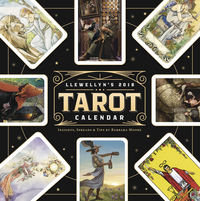
It is January and most people already have their calendars for 2018. However, if you don’t, you might consider Llewellyn’s 2018 Tarot Calendar.
Tarot readers often dream about seeing their beloved card art in a larger format. This calendar includes twelve beautiful cards at 5.5 x 9 inches. Each month features a different card from a different deck.
In addition to the beautiful image, each month includes two or three luscious tidbits plus a comment about the specific image shown. Tidbits include spreads, symbol meanings, tips, journal prompts, and techniques. For example, there are short explorations of interesting aspects of the cards, such as the Empress, the 3 of Pentacles, Justice, Temperance, the Hanged Man, and the Moon. There are tips like how to learn the subtle differences between seemingly similar cards or how to deepen understanding by connecting the Minor Arcana cards to their corresponding Majors.
Just like with Llewellyn’s Astrological calendar, there are articles at the back to help beginners or to refresh the memory of more experienced readers. Articles include how to begin your tarot journey, a glossary of terms, the meanings of the suits and numbers, the Celtic Cross spread, and the Fool’s Journey.
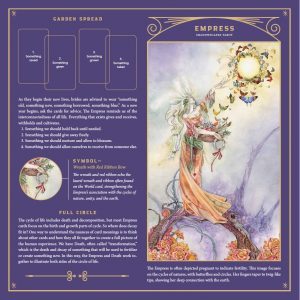
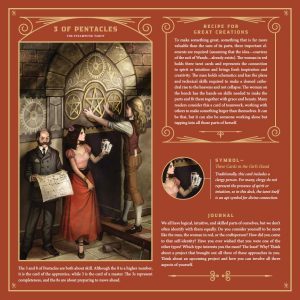
January 9, 2018
Reality Jumping (or, the Mandela Effect)
Readers, please enjoy this guest blog post by Aaron Leitch, author of several books, including Secrets of the Magickal Grimoires, The Angelical Language Volume I and Volume II, and Essential Enochian Grimoire.
Back in the 1990s, a ritual called the “Tesseract Working” appeared and was in vogue for a while. Based on the concept of multiple co-existing universes, it promised to allow one to jump from one universe to another at will. (Yes, like that old TV show Sliders—though that didn’t yet exist.) Frankly, the ritual wasn’t that mind-blowing. It had a Neopagan structure, and basically took you ritually through the entire Major Arcana of the Tarot. (The GD has been doing that for a hundred years…) At the time, I didn’t see what it had to do with jumping to another reality.
Over the years, however, I have experienced what I came to call “reality jumping” many times. You go through a major ritual (where a LOT of energy is raised) or experience a traumatic event, and suddenly you start noticing little differences around you. You might notice a few landmarks—like roads, buildings, or even natural features—have changed, vanished, or even appeared where they were not before. Maybe a different actor starred in a popular movie. You may remember events happening that others do not, or vice-versa. Maybe even someone who was dead is suddenly alive.
This isn’t a phenomenon reserved for occultists, either. It has become something of a subject in modern pop culture and social media—having acquired the name “Mandela Effect.” The name is based on Nelson Mandela, who a large number of people seem to remember dying as a political prisoner in South Africa in the 1980s. However, he actually passed away a free man just a few years ago in 2013. Another popular example is the children’s book series “The Berenstain Bears,” which many people (myself included) clearly recall being spelled “Berenstein” in the 1980s. If you do a quick web search for “Mandela Effect” you will find plenty of examples. And a rather large number of people have personal examples as well—probably moreso among occultists than most other groups.
As far as I can tell, it doesn’t take a specific ritual (like the Tesseract Working) to achieve this effect. It seems to happen quite naturally at times when a large amount of energy is raised—be it a ritual or a traumatic event. (I once suffered a traffic accident that I’m pretty sure killed both me and my wife—yet we both “came to,” completely unharmed, in a car that was in an entirely different place than physics said it should have been.) When it involves a ritual, it is as if you step “between the worlds” to enact the magick, and somehow step back into a different reality than the one you left. The changes are rarely drastic, and can in fact go unnoticed for some time even if you are looking for them. This makes sense if we think of these parallel realities as clusters of strings, where neighboring realities are very similar to one another, and the differences grow larger the further out you go. It’s not likely you’ll experience something so dramatic as an America that lost the Revolutionary War, or a world ruled by Nazis who won WWII, or where Cro-magnon Man came to dominate the planet. However, you might find a local road now has a different name. Or maybe the road wasn’t there before. And the example I gave above about different actors starring in popular movies—that one has happened to me and my wife. Sometimes it is fun to compare notes with others, to see where we have come together from other realities (we share the same memories of things that are now different) and where we have jumped alone (we share different memories of past events).
Occultist Nick Farrell has suggested this might even be how all magick works. Many years ago I contemplated the same possibility: what if all magick is merely the method of programming the destination of your trip, to “slide” into a reality where what you desire already exists? I admit it is an intriguing thought, with seemingly endless possibilities. However, after well over twenty years of observation, I am not at all convinced this is something we can program or control. Simple spells, or magick done through your familiar spirits, do not apparently result in a reality jump—it seems to take massive amounts of spiritual energy to accomplish. (So think of initiation ceremonies, large Sabbats, evocation rituals, etc.) And I see no way to write a ritual that would guarantee a target destination. It appears to be random, its scope is limited, and I have found no real practical use for it.
However, that doesn’t stop it from being endlessly fascinating. It is an experience all humans share, and which just a few of us are crazy enough to seek out. And it absolutely says something about how the universe (or omniverse, as the case may be) works under the hood. I’m willing to bet most of you have your own “Mandela Effect” experiences, especially associated directly with your magical work. Feel free to share them!
Our thanks to Aaron for his guest post! Visit Aaron Leitch’s author page for more information, including articles and his books.
January 8, 2018
Your Right Why
Readers, please enjoy this guest blog post by Jennie Lee, author of True Yoga and the new Breathing Love.
 When something challenging happens, the first thing we usually cry is, “Why?!” Think of the last unfortunate occurrence in your life. How much time and energy did you expend wondering, “Why this? Why now? Why me?” As natural as this is, it is not really helpful. In fact, we can get so stuck in the misery of wondering why a particular experience has happened that we paralyze ourselves from being able to respond effectively.
When something challenging happens, the first thing we usually cry is, “Why?!” Think of the last unfortunate occurrence in your life. How much time and energy did you expend wondering, “Why this? Why now? Why me?” As natural as this is, it is not really helpful. In fact, we can get so stuck in the misery of wondering why a particular experience has happened that we paralyze ourselves from being able to respond effectively.
It is far more beneficial to accept each life event as it is happening and conserve our energy to determine what we need to learn and how we need to move forward. By doing this, we leave the role of victim behind and move toward self-actualization. A more empowering “why” we can ask is, “Why am I responding the way that I am?” Do my speech and actions support my essential belief in why I am alive and how I want to live?
Love As our Best Why
To be ready for the challenging moments that inevitably come, it helps to create a clear definition of our non-negotiable inner commitments. These are linked to our fundamental values in life, and they inform all the outer movements we make. Unlike goals that define what we want to accomplish in life, inner commitments define essentially why we do what we do. Think of them as intentions that lead us closer to external goals. Here are some examples:
To make choices based on love, not fear
To prioritize personal spiritual growth
To share vulnerability rather than hide in distrust
To live mindfully, present in each moment
To know our true spiritual Self
To live more from soul and less from ego
Without being really clear about our motivations, we cannot hope to accomplish what we dream of in life, and we will forever be thrown off center when difficulties come our way. Ultimately, to stay strong and on course, we must ask the most fundamental “why” of all: “Why am I here?”
For me, the answer to why I am here, and why I do what I do, is simply to learn how to love and be loved. I fuel this intention and inner commitment by my practice of breathing love in every circumstance and in every relationship life brings my way, to the best of my ability each day. This keeps me anchored in my highest value system and prevents me from dwelling on the futile version of the question “Why?”
As we determine our right “why,” we craft a conscious life and make meaning out of any challenges that are part of the journey.
Our thanks to Jennie for her guest post! For more from Jennie Lee, read her article “Living Love Daily.”
January 4, 2018
Be a Part of the YOGA RISING Virtual Book Reading Series!
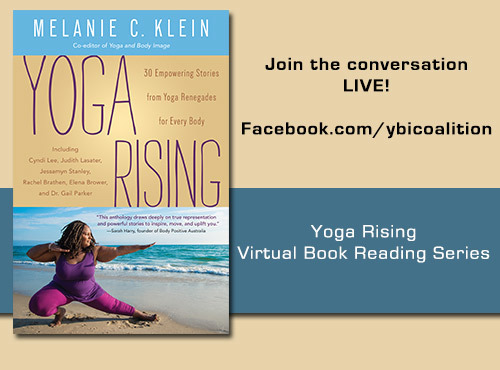
“Being a yoga renegade means we resist and, more importantly, we persist in challenging and changing the limited narrative of who does yoga and #whatayogilookslike as represented in the dominant culture—and far beyond the practice, culture and business of yoga into the culture at large. I believe there is a yoga renegade in all of us…”—Dianne Bondy, foreword of Yoga Rising
To celebrate the release of Melanie Klein’s newest anthology Yoga Rising: 30 Empowering Stories from Yoga Renegades for Every Body, Melanie Klein and the Yoga and Body Image Coalition are proud to offer a virtual book tour to help everyone kick off 2018 in the most inspired and empowering way possible!
Join Melanie Klein, Dianne Bondy, and many other contributors no matter where you may reside in the world. Simply hop on over to the Yoga and Body Image Coalition’s Facebook page on the following dates and times to hear Yoga Rising contributors read from and discuss their contributions in this powerhouse collection.
(Note: all times reflect the Eastern time zone.)
Monday, January 8 @ 9:30am: Melanie Klein
Tuesday, January 9 @ TBD: Dianne Bondy
Wednesday, January 10 @ 4pm: Jodi Strock
Thursday, January 11 @2:30pm: Robyn Baker
Friday, January 12 @ 1pm: Gwen Soffer
Saturday, January 13 @ 5pm: Dana Smith
Sunday, January 14 @ 5pm: Dr. Gail Parker
Monday, January 15 @ 1:30pm: Dana Byerlee
Can’t make it live? No problem! Catch the archived chats by scrolling down the YBIC’s Facebook feed.
Be sure to check back and stay tuned by following @ybicoalition on Instagram as more dates and contributors will be added throughout the month.
And don’t forget to participate in the #YogaRisingBook Campaign that the Yoga and Body Image Coalition and Llewellyn Worldwide are co-hosting over on Instagram. Melanie Klein is offering 3 FREE spots in the next Yoga & Body Image Online Immersion offered this March. Check out the details here.
Llewellyn Publications's Blog
- Llewellyn Publications's profile
- 243 followers



